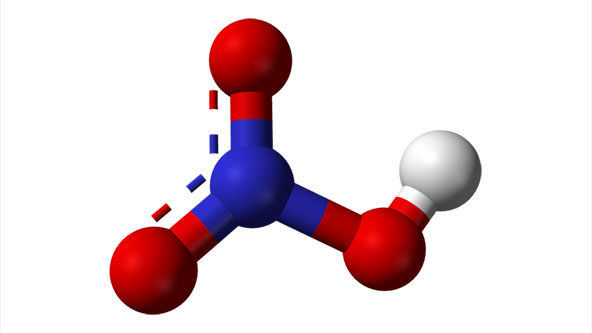What is Nitric Acid?
Commonly used in fertilizers (and in rare occasions even explosives) Nitric acid is a colorless or yellow liquid with a characteristically acrid, caustic odor and corrosive properties. This mineral acid has a variety of applications and presents several health hazards if used without the necessary safety precautions. Here are some important tips about safely handling and storing nitric acid in the workplace, from the experts at VelocityEHS.
Common Uses of Nitric Acid
Also known as aqua fortis or spirit of niter, nitric acid is used for nitration to create nitro compounds in laboratory or industrial settings. The resulting chemical compounds range in stability, so they can be used in the manufacture of a wide variety of products, including:
- Explosives
- Ammunition
- Rocket propellant
- Inks and dyes
- Aging pine and maple wood
- Commercial cleaning agents
Health Hazards Associated with Nitric Acid
Nitric acid is an extremely corrosive acid capable of causing severe chemical burns very rapidly. If nitric acid mists are inhaled, health risks include corrosion of mucous membranes, delayed pulmonary edema, and even death. Contact with eyes can cause permanent cornea damage. In addition, if ingested, nitric acid can produce severe, rapid corrosive burns of the mouth, throat and gastrointestinal tract.
This chemical can also react violently with certain compounds such as metallic powders and turpentine, and is a strong oxidizer capable of causing fires if it comes in contact with organic material. Because of the hazards posed by nitric acid, it is important to take strict safety measures whenever handling it.
Nitric Acid Safety, Handling & First Aid
When handling nitric acid in the workplace, we strongly recommend you wear chemical safety glasses, a face shield for splash protection, gloves, and an approved vapor respirator if adequate ventilation is not available. As an added safety precaution, eyewash stations and washing facilities should be easily accessible. In the event of exposure to nitric acid, follow these first aid guidelines:
- Inhalation – Seek fresh air and immediate medical attention.
- Eye Contact – Immediately flush eyes with plenty of water for at least 15 minutes to prevent further damage, seeking medical attention immediately as well.
- Skin Contact – Immediately flush affected area with plenty of water for at least 15 minutes. Remove contaminated clothing and wash with soap. Immediate medical attention is required.
- Ingestion—Do NOT induce vomiting. Rinse mouth with water and give a glass of water or milk. Never give anything by mouth to an unconscious person. Seek medical attention immediately.
Safe Storage & Disposal of Nitric Acid
Store nitric acid in a secure area away from incompatible materials such as organic compounds, metals, alcohols or moisture. Keep container tightly closed in a cool, dry, well-ventilated area. Due to its high risk of adverse health effects, this chemical must be disposed of in accordance with federal, state, and local environmental control regulations.
Learn More about Nitric Acid & Other Hazardous Workplace Chemicals
If you are in charge of chemical safety for your organization, it’s essential to make sure your workforce is well informed on all the risks of nitric acid and other potential dangers in the workplace. Browse our extensive database of MSDS information to learn more.
